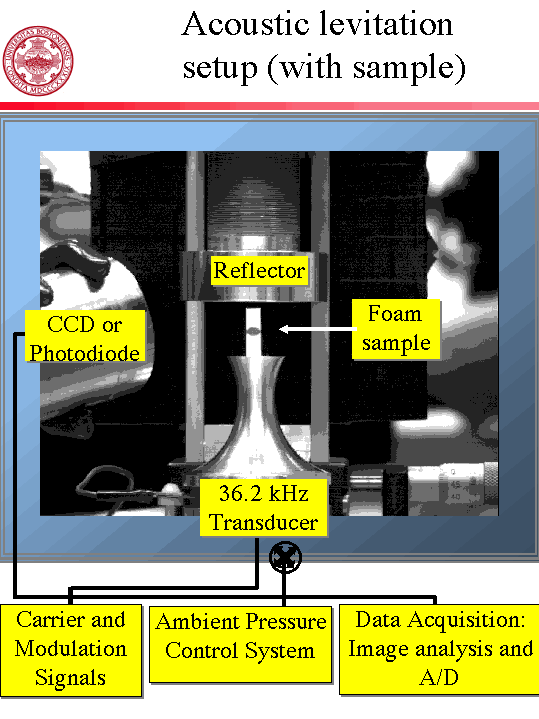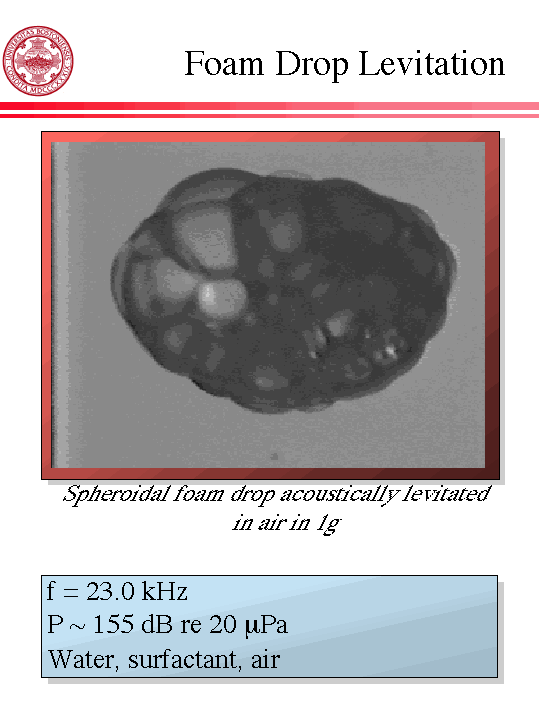


Glynn Holt, rgholt@bu.edu
Greg McDaniel, jgm@bu.edu
Dept. of Aerospace and Mechanical Engineering
Boston University
110 Cummington St.
Boston, MA 02215
Popular version of paper 1pPA1
Presented Monday afternoon, October 12 ,1998
136th ASA Meeting, Norfolk, VA
A foam is an everyday substance - you find foam in your bubble bath, in a can of shaving cream, on top of a carbonated beverage, and in a typical household fire extinguisher. Foams also play an important role in many industrial processes such as particle removal and enhanced oil recovery. Experiments are underway at Boston University to provide a basic understanding of the dynamics of such wet foams. The experiments are revealing how foams respond to applied pressures so that, among other things, their delivery in industrial applications may be improved and new applications may be proposed.
Foam dynamics have historically been difficult to experimentally characterize because of the effect of gravity. First, you need a container to hold the foam in place (or at least some surface to rest on). The contact force between the container and the foam will will change the behavior of the foam. Second, the liquid in between the bubbles (see Figure 1) will drain over time, ultimately destroying the foam.
In our experiments, we defy gravity by acoustically levitating foam drops (see Figure 2). The levitation device consists of a vibrating surface (transducer) and a reflector that conspire to create an ``acoustic valley'' in the air that suspends the drop without touching it. By varying the parameters of this ultrasonic acoustic wave, we can both levitate and squeeze the sample of foam, making it look like a flattened sphere (see Figure 3).
We can float a foam, but on earth it is difficult to overcome the drainage problem. That is why NASA has become interested in the problem - by performing acoustic levitation experiments in a low-gravity environment (such as those NASA can provide in drop towers, sounding rockets, KC-135 parabolic flights or Space Shuttle flights) we can (for a time) reduce or remove the effects of gravity from the problem, all the while maintaining the advantages of non-contact manipulation that acoustics provides.
Foams are geometrically complex mixtures of bubbles and liquids. In particular, when the bubbles are brought close together their shapes lose their sphericity and become polyhedra. How a foam with millions of such bubbles will vibrate would appear to be an unfathomable mystery. However, work by others suggests that at low pressures and frequencies foams behave like a viscoelastic solid, such as rubber, that is characterized by only four frequency-dependent material parameters. We have designed our initial experiments to test this hypothesis, and, if the hypothesis is true, to determine these parameters.
The experiments will accomplish this by finding the natural frequencies of an approximately spherical foam drop much like the one shown in Fig. 3. The natural frequencies, which are determined by the size of the drop and by the four parameters mentioned above, are found by modulating the amplitude of the levitation pressure until the foam drop vibrates at large amplitude. Interestingly, the theory that relates the natural frequencies to the material parameters of the sphere was first developed to estimate the properties of a larger approximate sphere known as the earth.
As part of the Education in Acoustics "Demos 2000" special session, we will have a working acoustic levitator set up. In "Acoustic levitation of drops in air", a contributed talk (3aED9, Wednesday, 12:30 pm in Ballroom 4 & 5) we wlll demonstrate the acoustic levitation of liquid drops in an ultrasonic acoustic levitator apparatus. We will also demonstrate levitation and oscillation of foam samples nearly identical to those which are the subject of our foam rheology study.
As part of the Education in Acoustics "Demos 2000" special session, we will have a working acoustic levitator set up. In "Acoustic levitation of drops in air", a contributed talk (3aED9, Wednesday, 12:30 pm in Ballroom 4 & 5) we wlll demonstrate the acoustic levitation of liquid drops in an ultrasonic acoustic levitator apparatus. We will also demonstrate levitation and oscillation of foam samples nearly identical to those which are the subject of our foam rheology study.

Figure 1

Figure 2

Figure 3